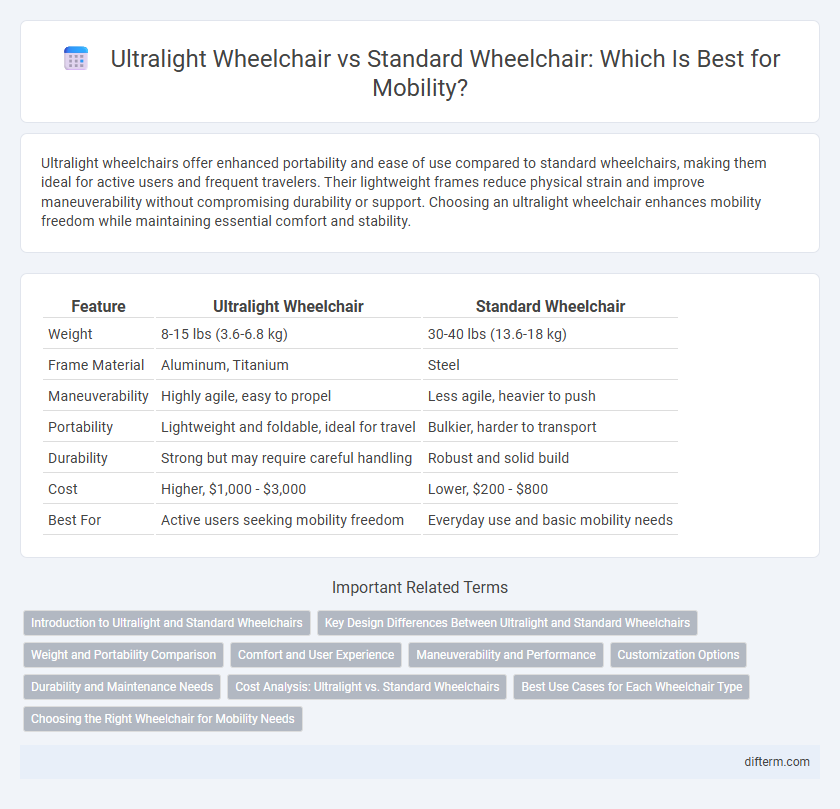Ultralight wheelchairs offer enhanced portability and ease of use compared to standard wheelchairs, making them ideal for active users and frequent travelers. Their lightweight frames reduce physical strain and improve maneuverability without compromising durability or support. Choosing an ultralight wheelchair enhances mobility freedom while maintaining essential comfort and stability.
Table of Comparison
| Feature | Ultralight Wheelchair | Standard Wheelchair |
|---|---|---|
| Weight | 8-15 lbs (3.6-6.8 kg) | 30-40 lbs (13.6-18 kg) |
| Frame Material | Aluminum, Titanium | Steel |
| Maneuverability | Highly agile, easy to propel | Less agile, heavier to push |
| Portability | Lightweight and foldable, ideal for travel | Bulkier, harder to transport |
| Durability | Strong but may require careful handling | Robust and solid build |
| Cost | Higher, $1,000 - $3,000 | Lower, $200 - $800 |
| Best For | Active users seeking mobility freedom | Everyday use and basic mobility needs |
Introduction to Ultralight and Standard Wheelchairs
Ultralight wheelchairs typically weigh between 14 to 30 pounds, offering enhanced portability and maneuverability compared to standard wheelchairs, which often weigh 35 to 50 pounds or more. Constructed from advanced materials like aluminum or titanium, ultralight models improve user independence by enabling easier self-propulsion and transport. Standard wheelchairs, usually made from steel or heavier metals, provide durability and stability but can limit mobility due to their increased weight and bulk.
Key Design Differences Between Ultralight and Standard Wheelchairs
Ultralight wheelchairs feature a frame made from high-strength materials such as aluminum or titanium, resulting in significantly reduced weight compared to standard wheelchairs that often use heavier steel frames. The design of ultralight wheelchairs emphasizes compactness and adjustability, with components like quick-release wheels and ergonomic seating to enhance user mobility and comfort. Standard wheelchairs prioritize durability and affordability, often sacrificing weight and customization options present in ultralight models.
Weight and Portability Comparison
Ultralight wheelchairs typically weigh between 15 to 25 pounds, significantly lighter than standard wheelchairs, which often range from 30 to 40 pounds. This reduced weight enhances portability, making ultralight models easier to lift, transport, and maneuver in tight spaces. Many ultralight wheelchairs feature foldable frames and compact designs, further improving their convenience for travel and daily use compared to bulkier standard wheelchairs.
Comfort and User Experience
Ultralight wheelchairs offer enhanced comfort through customizable seating and reduced weight, minimizing user fatigue during extended use. These wheelchairs provide superior maneuverability and ease of transport, significantly improving daily user experience compared to standard models. Standard wheelchairs tend to weigh more, which can lead to discomfort and limited independence for active users.
Maneuverability and Performance
Ultralight wheelchairs offer superior maneuverability due to their reduced weight and streamlined frame, enabling easier navigation in tight spaces and quicker response to user movements. Their performance exceeds standard wheelchairs by providing enhanced speed and agility, which is critical for active users requiring efficient mobility throughout daily activities. Standard wheelchairs, while typically more robust, often sacrifice agility and acceleration, making ultralight models preferable for those prioritizing dynamic and effortless maneuvering.
Customization Options
Ultralight wheelchairs offer extensive customization options tailored to individual user needs, including adjustable seat heights, removable armrests, and customizable wheel camber for improved maneuverability. Standard wheelchairs typically have limited customization, focusing on basic size and comfort adjustments without advanced personalization features. Customization in ultralight models enhances user mobility, ergonomics, and overall comfort, making them ideal for active lifestyles and specific medical requirements.
Durability and Maintenance Needs
Ultralight wheelchairs offer enhanced durability through high-quality materials such as aluminum or titanium, significantly reducing wear and tear compared to standard wheelchairs made from steel or heavy-duty alloys. Maintenance needs for ultralight wheelchairs are generally lower due to their corrosion-resistant frames and modular components designed for easy replacement. Standard wheelchairs often require more frequent repairs and upkeep, especially in high-use scenarios, due to their heavier construction and less advanced materials.
Cost Analysis: Ultralight vs. Standard Wheelchairs
Ultralight wheelchairs typically cost between $1,000 and $3,000, whereas standard wheelchairs range from $300 to $800, reflecting a significant initial price difference. The higher upfront investment in ultralight models can lead to long-term savings through enhanced durability, reduced maintenance, and improved user mobility that lowers healthcare costs. Considering factors like weight-related fatigue and transportation expenses, ultralight wheelchairs often provide better overall cost efficiency despite their premium price.
Best Use Cases for Each Wheelchair Type
Ultralight wheelchairs excel in active users requiring enhanced mobility, portability, and ease of transport, making them ideal for sports, travel, and daily use in varied environments. Standard wheelchairs offer robust support and durability suited for users with limited upper body strength or those needing long-term stationary use in home or medical settings. Choosing between ultralight and standard wheelchairs depends on activity level, portability needs, and user strength for optimal comfort and functionality.
Choosing the Right Wheelchair for Mobility Needs
Ultralight wheelchairs offer enhanced portability and ease of maneuverability, making them ideal for active users who prioritize independence and frequent travel. Standard wheelchairs provide robust durability and often support higher weight capacities, suitable for individuals requiring more stability and less frequent transportation. Evaluating personal lifestyle, daily mobility demands, and physical requirements ensures selecting a wheelchair that optimally balances comfort, functionality, and accessibility.
ultralight wheelchair vs standard wheelchair Infographic

 difterm.com
difterm.com